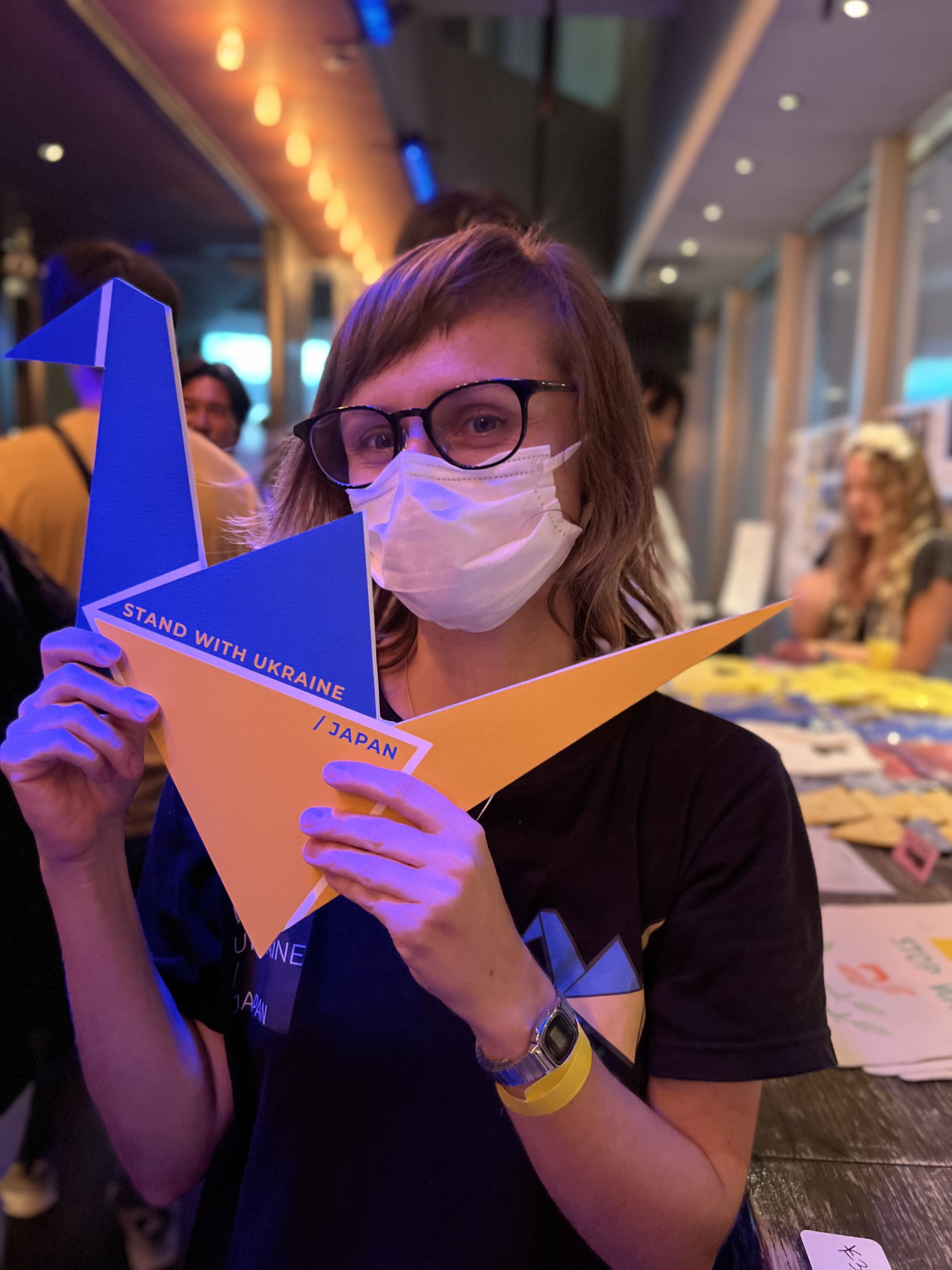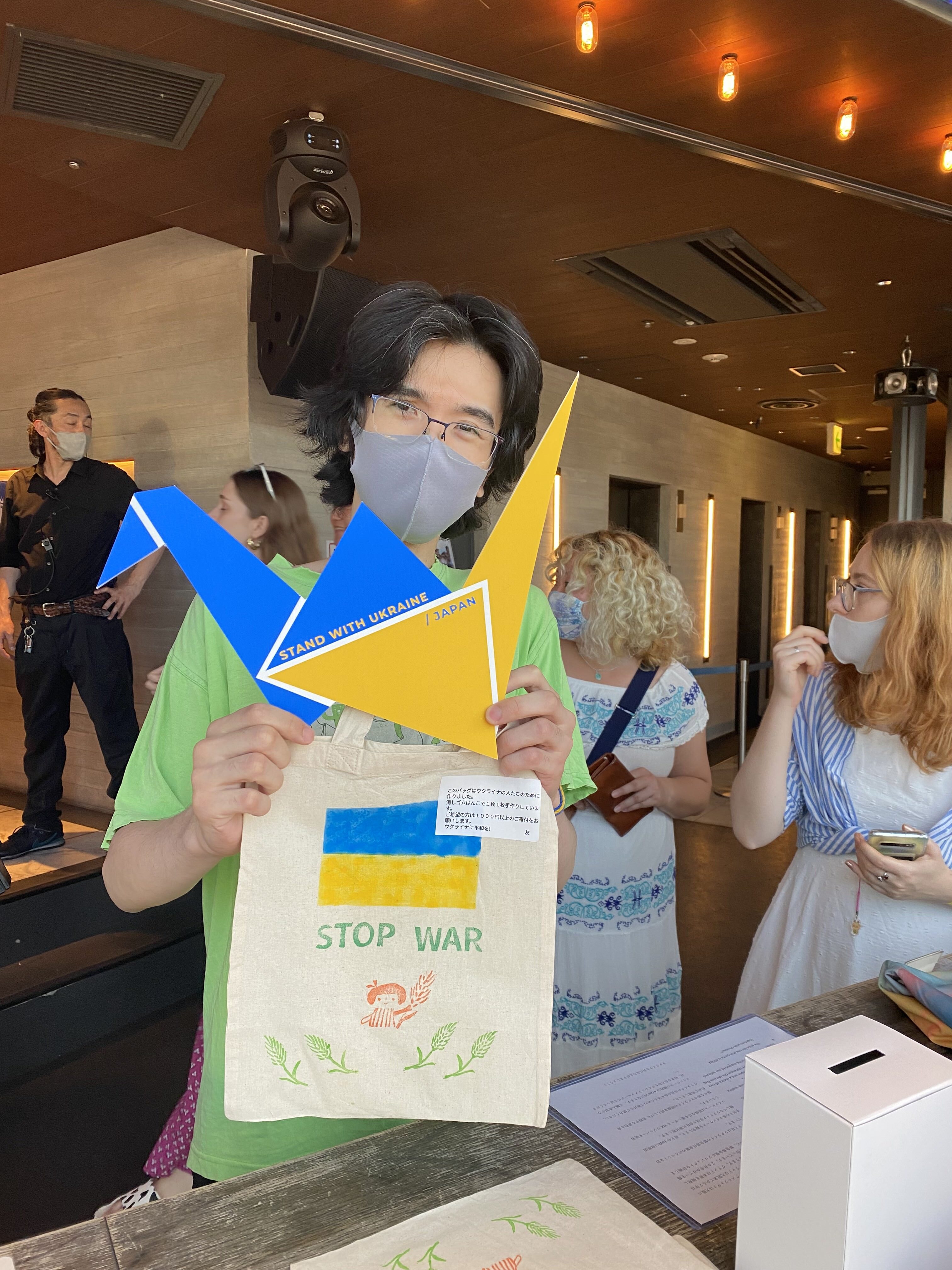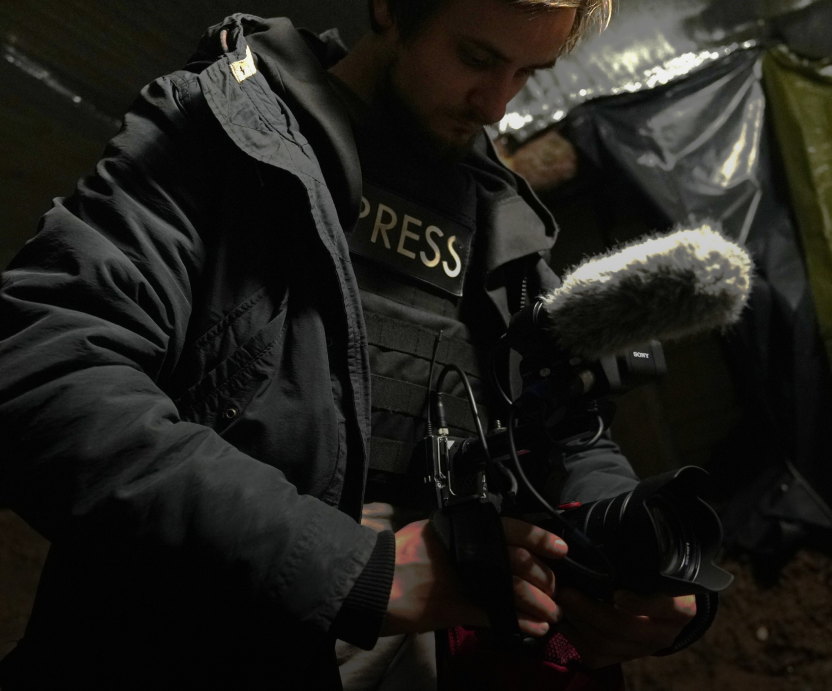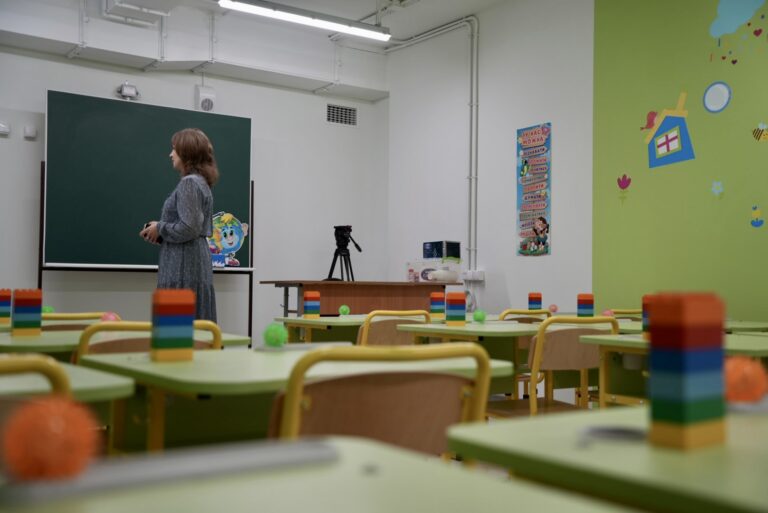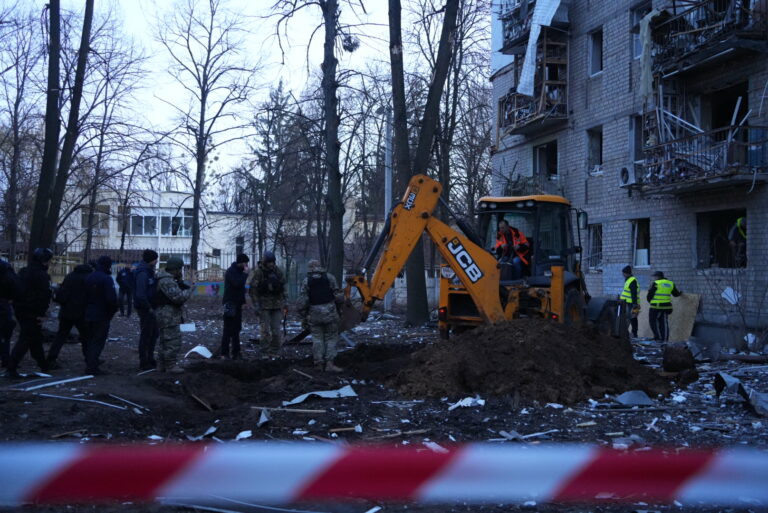Three stories of girls who have returned to their native city after a long time and compare Kharkiv before the war and now.
Imagine yourself waking up one morning to the sound of explosions and urgently leaving your cozy flat forever.
Imagine yourself going on a business trip for a few days and staying there for six months, unable to return home.
Imagine yourself living as an expat abroad and finding out your homeland is at war and your parents and friends are in danger.
Imagine your native city where you’ve made your first steps, learned your first lessons, met your first friends, and probably bought your first cigarettes.
Imagine yourself leaving it forever.
Imagine yourself returning there.
That’s exactly what happened to Tanya, Alisa, and Sasha – young women from Kharkiv who left the city and then returned to compare Kharkiv before the war and now.
“You should return to Kharkiv only if you know what to do there”. Tanya Shorokhova about Kharkiv before and now
Tanya Shorokhova, 37, used to be a creative director at Ohana SMM Agency, one of the most successful marketing agencies in Kharkiv. Outside work, Tanya enjoyed crafting brooches with an imaginary character, elephant-fly Afanasiy, going to dance parties, and exploring the coffee and restaurant scene of the city.
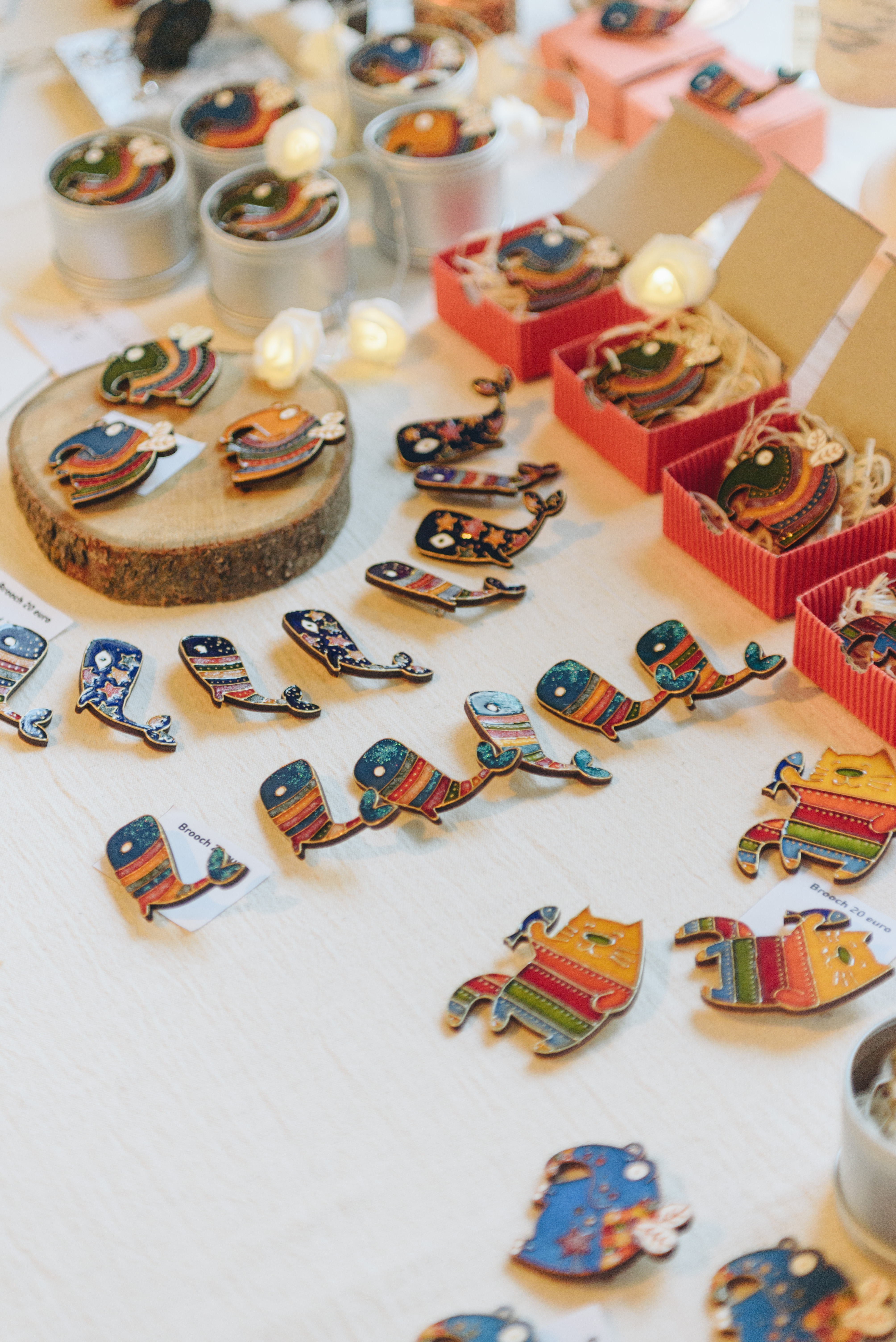
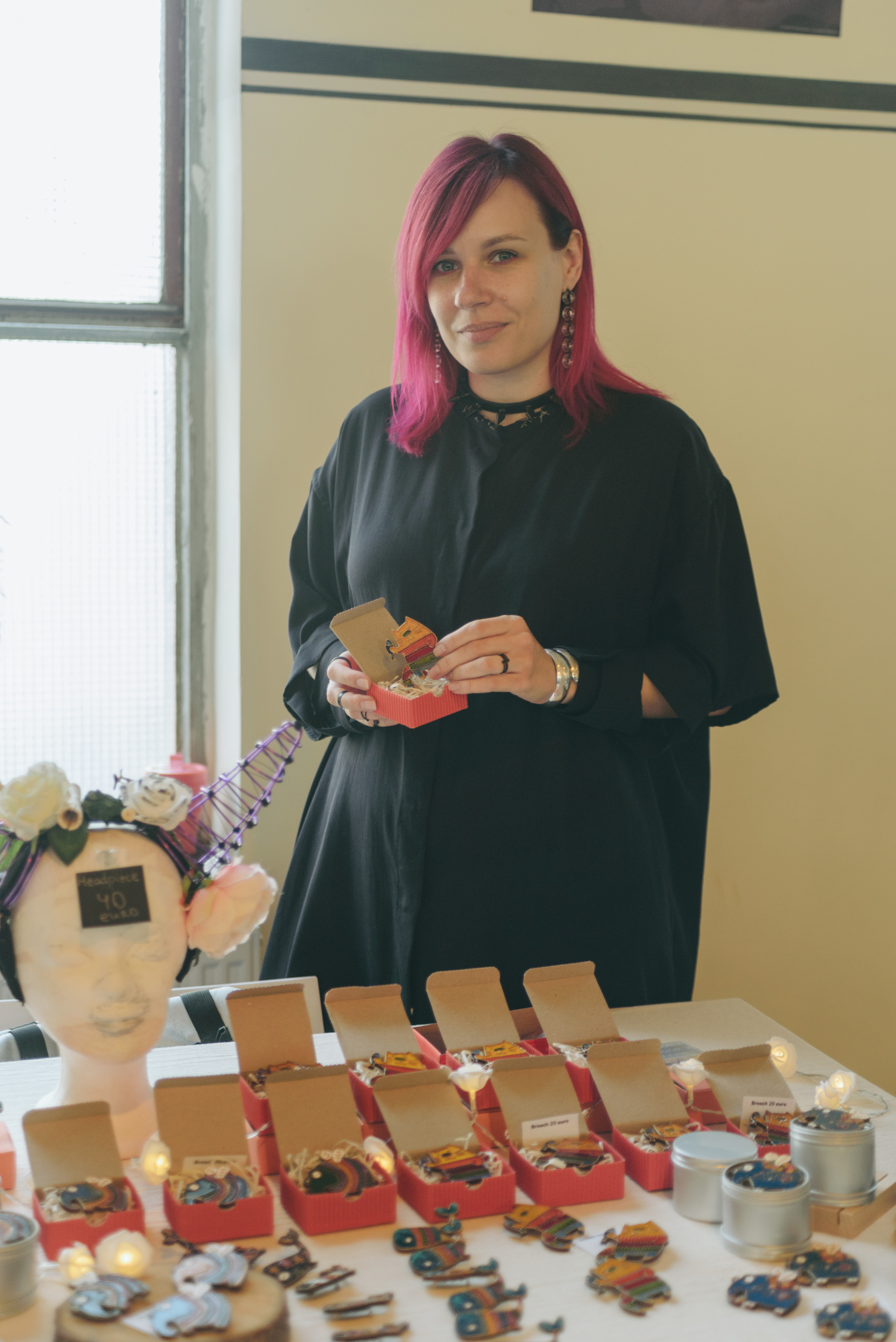
All that changed on Feb. 24, when Tanya woke up in her brand new rented apartment in the heart of the city to the sound of shelling. Though it was hard to imagine war would happen, Tanya and her friend had planned for this horrible event and as the war started she grabbed her bag and jumped into the car. For the first week, Tanya stayed in the central part of Ukraine, then fled to Germany.
On Sept. 19, Tanya returned to Kharkiv. She wanted to hug her family, who refused to leave the city, and to see all the places she had been missing so badly. Before the war, Tanya had never parted with her beloved Kharkiv for more than two months.
“For the first 24 hours in Kharkiv, I felt so very excited. I hugged my Mom and my brother, slept in my bed, and petted my cat. It was sunny, and I was happier than I’d felt in the past six months,” confesses Tanya.
The next day she had an appointment with the dentist which meant she had to go to the city center. Tanya was nervous, as it felt like “facing the fact my life is completely ruined”.
“I was afraid to go to the city center, but not because of the shelling. My office used to be there, I loved my job and have succeeded in it, starting from scratch four years ago and eventually becoming a creative director. We had more than 20 brands among clients. Now only one client is left, and my office doesn’t even exist.”

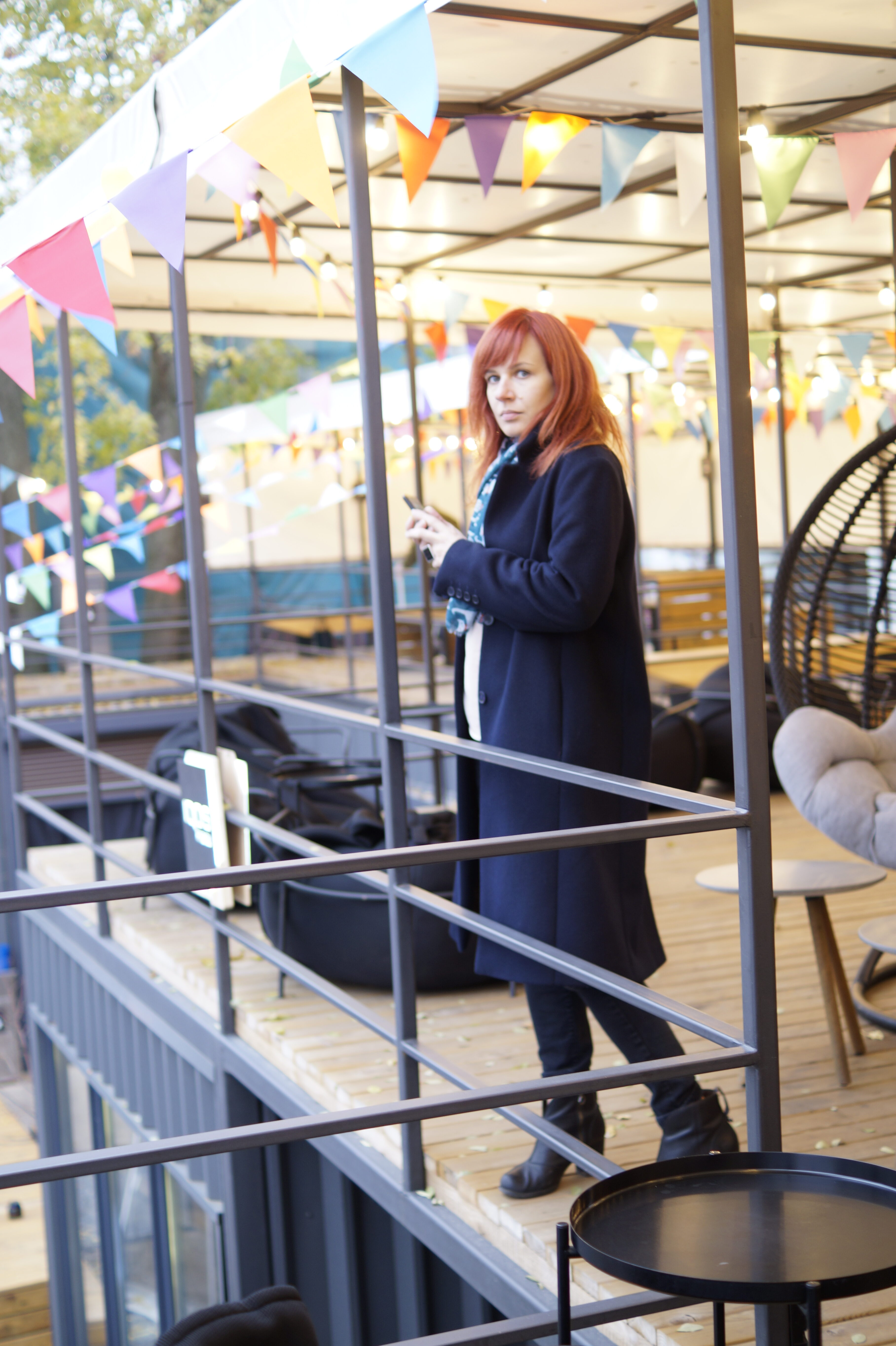
Tanya`s favorite place, Culture street, was empty. It had been difficult to find a place for parking before the war in Kharkiv, but now there were only two cars. The Spar supermarket and the cafes were closed (as of the moment of publication Spar has re-opened), but a vape shop, a milk store, the bar, and the typography were open.
Kharkiv before and now remains the same city. Tanya says the news and social media made an impression that the city had been turned into a ruin, but when you come you see the green lawns, flower beds, clean streets, and retired women selling apples. “The consequences of shelling are immediately eliminated. So you walk the central Sumska street and see the grass and the flowers, people having coffee in the cafes. And then you notice that the buildings are actually damaged.”
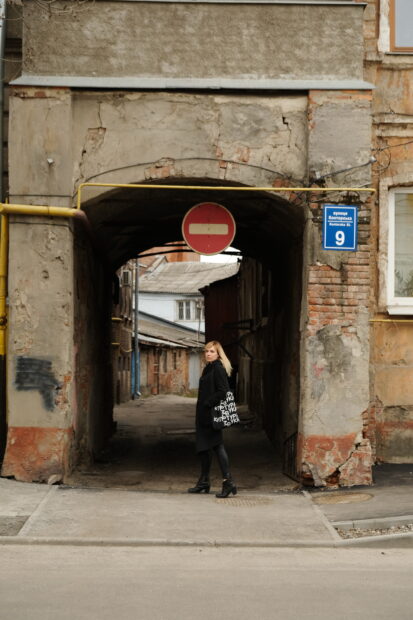
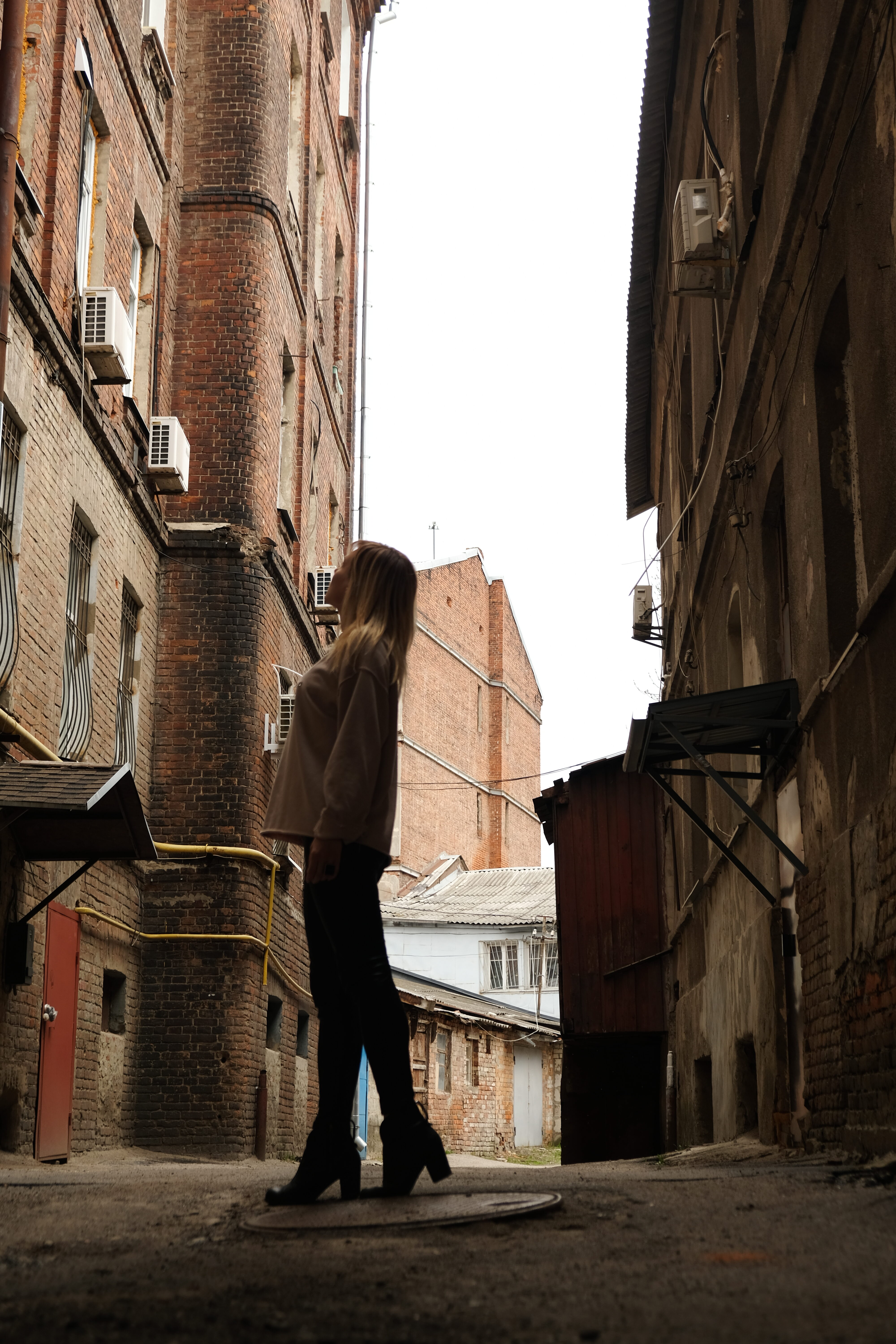
Sometimes it’s easy to forget about the war. You come to your favorite cafe, eat your regular salad and talk to a friend. You are discussing war, and all the people around are discussing war. But it still feels like normal life. And then you go outside, see the empty streets and damaged buildings, and think “oh man, there`s war in the city”.
“What impressed me the most was the spirit of Kharkiv citizens. They continue planting lawns, opening new restaurants, and walking in the parks. Life goes on, and people continue it even to the accompaniment of air raid sirens. Kharkiv residents are tired of hiding and just go on with their business no matter what”.
According to Tanya, she felt more scared watching the news about Kharkiv than actually staying in the city. “You are going somewhere, then you hear the siren. You check the Telegram channel – are there rockets flying from Belgorod? If not, you just continue what you`ve been doing”. This life is the new Kharkiv normality.
“But I don’t want to sound as if everything is fine here. No, it’s definitely not, it’s dangerous and difficult, and the city center is deserted. What I’m saying is if you love Kharkiv you will be happy there. Even now.”
Kharkiv before and now: 3 main changes Tanya noticed in the city
- Roadblocks on the city avenues to stop the enemy`s tanks.
- Suspiciousness towards people who take photos, sometimes even a prohibition to photograph particular buildings.
- Deserted streets in the city center.
“The atmosphere in the city reminds me of lazy Sunday mornings when the streets are deserted waiting for people, who are about to leave their warm apartments to meet their friends for coffee. But nobody will come, as nobody’s home.”

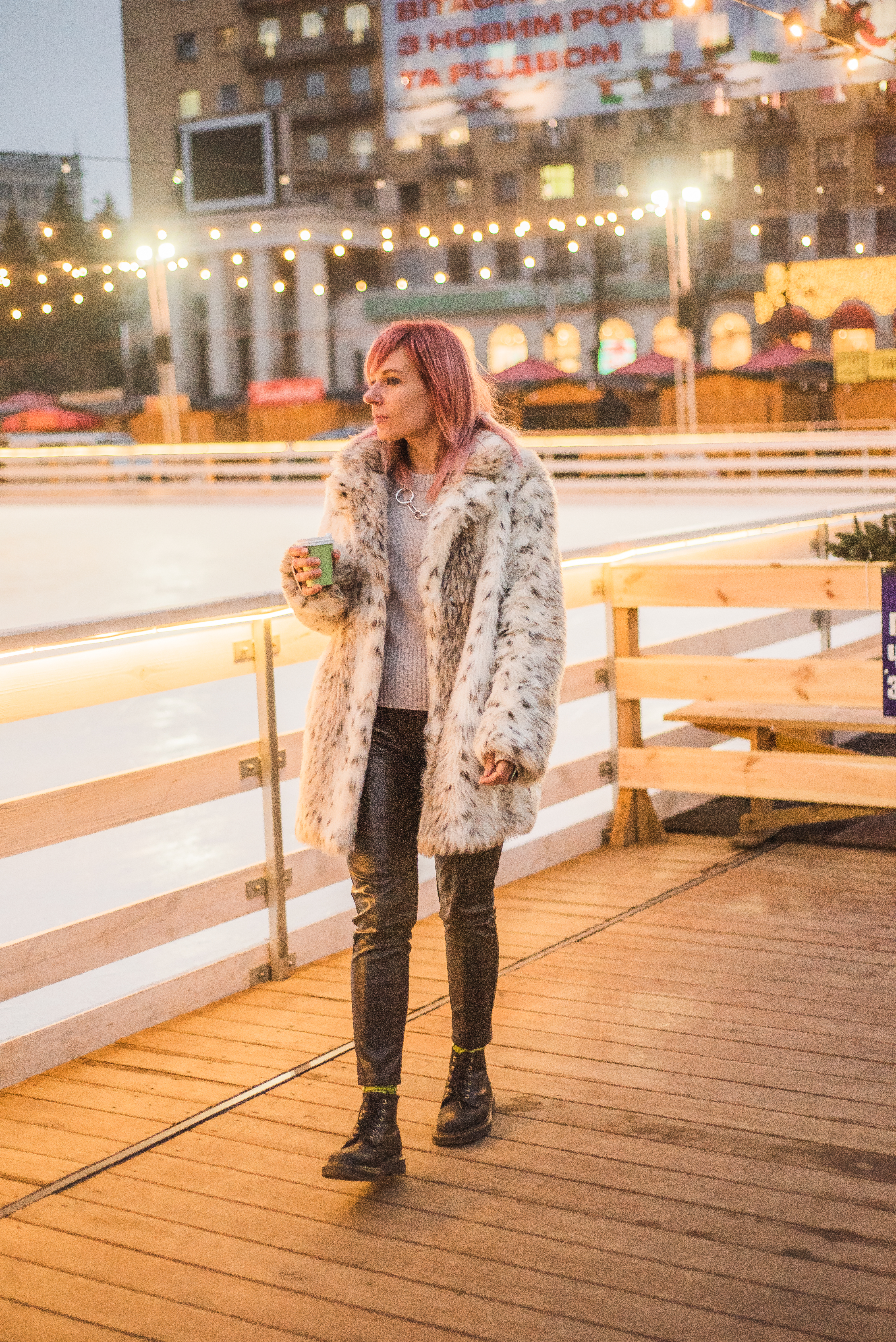
Tanya confesses being at home felt so good she would stay in Kharkiv if she didn`t have existing bureaucratic obligations in Germany. At the same time, Tanya understands that it was comparatively safe during her stay in the city – she has heard “only two explosions in seven days”.
Besides, there is no work for a marketing specialist in Kharkiv now. The main conclusion Tanya made was that one should return to the city only knowing what to do there. “It’s ok if you have a job or want to volunteer, rebuild Kharkiv, and know how you can contribute”. Otherwise, there’s no point in coming back and being inactive.
Ten days later, Tanya returned to Berlin. But she dreams of being back home when the war is over.
“Being in Kharkiv is like looking at the injured person you love. You recognize them, it’s still them – but they’re injured. On the one hand, it feels so good to be home. On the other – you clearly see what the Russians have done to us”.
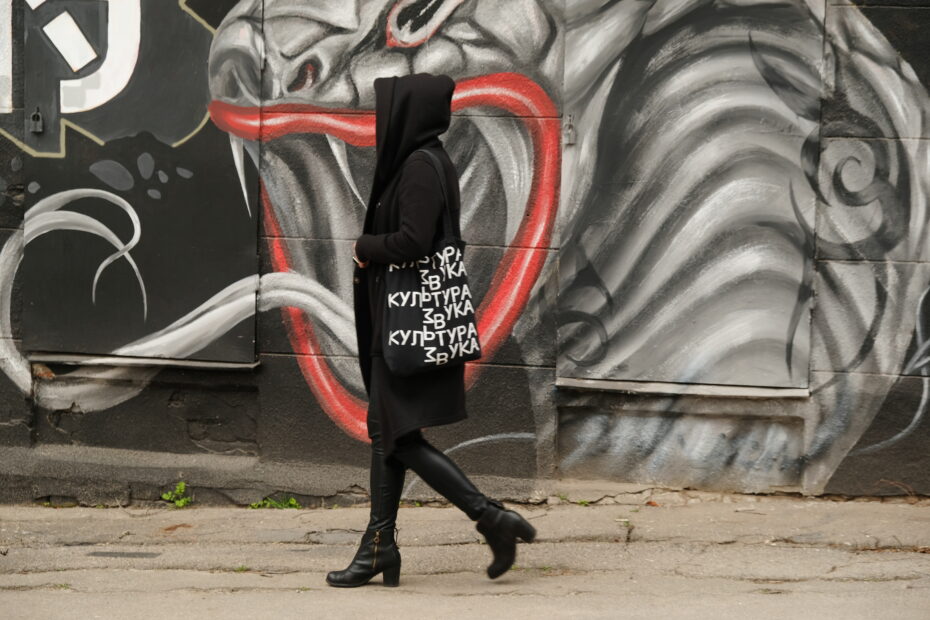
“Kharkiv now is like a feral cat: injured, alarmed, but still alive and warm-hearted.” Alisa Volkova on Kharkiv before and after war
Alisa Volkova, 29, is a game designer and playback theater performer. On Feb. 17, Alisa left Kharkiv with her theater “Vakhtery” (“Watchers”) for 10 days to perform in Lithuania. Her next meeting with her native city happened six months later, in August.
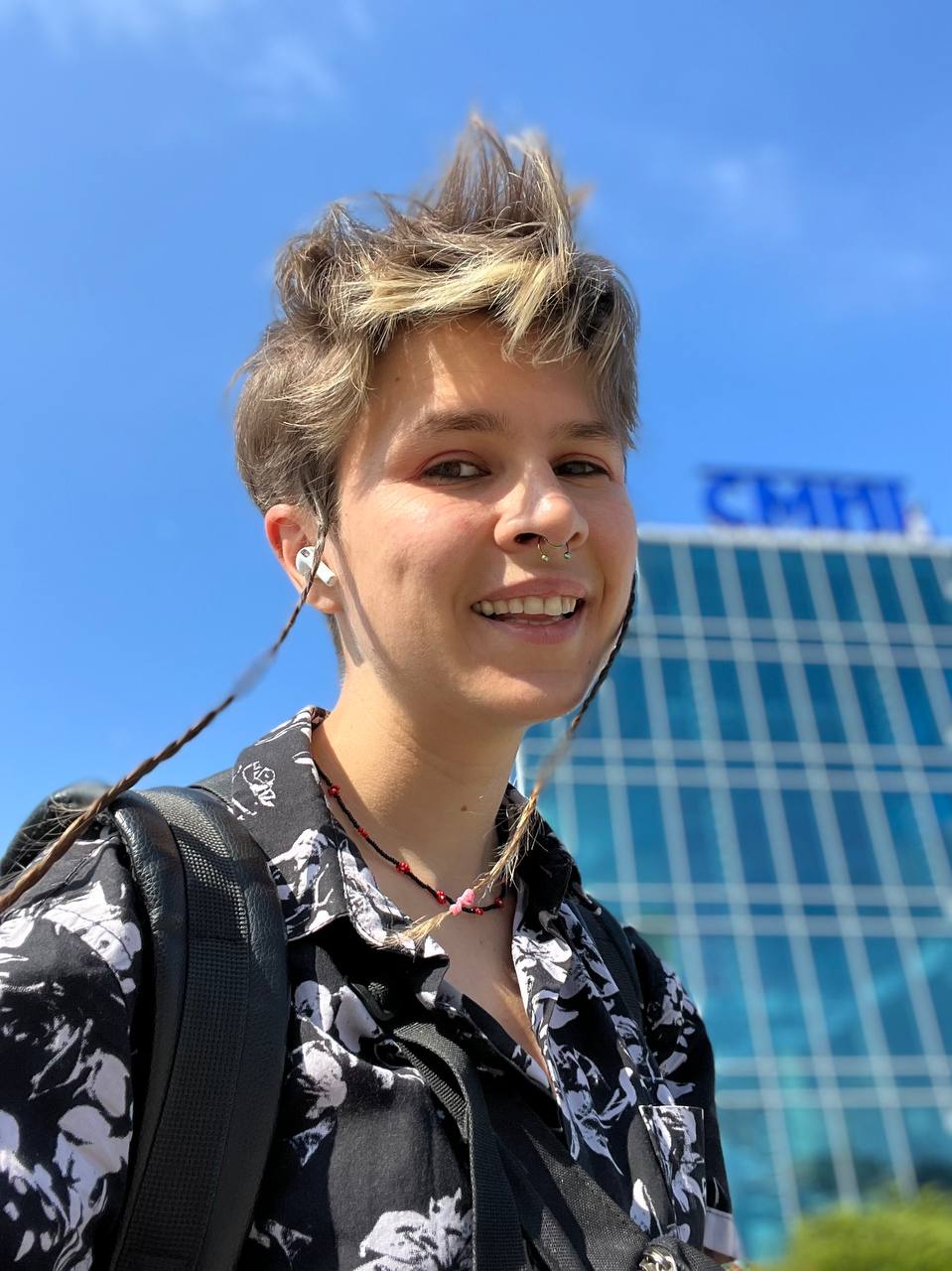
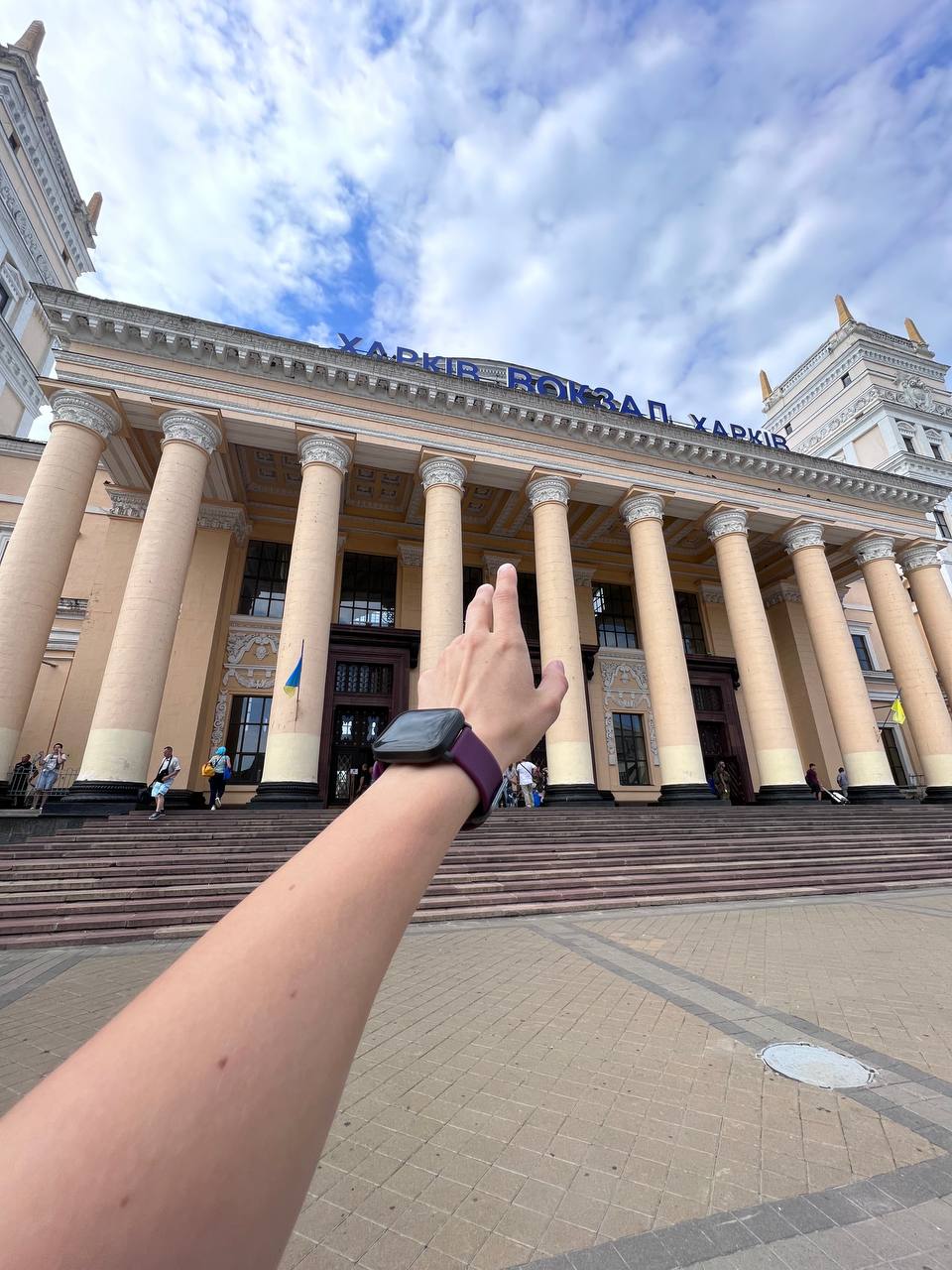
Alisa came to Kharkiv to see her family, walk her favorite streets and collect some of her personal belongings.
“It’s not about the practical need of some particular things – eventually, you have Fashion Weeks in the Humanitarian Aid Refugee centers,” smiles Alisa. “It’s not a problem for me to wear the same clothes for a month. What matters is that the things from home are really yours. And it helps to feel at least a bit more at home when you`re staying in a foreign country.”
Alisa found temporary refuge in Lithuania and had been planning a trip to Kharkiv since May. But the route was complicated – two days on the road and from three to seven hours at the border sounded challenging. Though Alisa visited Ukraine twice, delivering humanitarian aid with the volunteers, she didn`t travel across the country, staying in Lviv. “It felt so nice to be even there. The place you feel at home, you understand all the signs and the language, you know where to get good coffee and you constantly meet friends. Lviv has become the second Kharkiv at wartime, as many people from the east have moved there”.
Finally, in late August Alisa managed to get to Kharkiv. She wanted to reflect on temporarily saying goodbye to “the city of her heart” that she’s been living in for her whole life.
“I felt a bit anxious, as I didn`t know what to expect. I’ve already heard the air radar sirens in Lviv, but I`ve never heard the explosions. But the closer I got to Kharkiv the calmer I felt. The anxious feelings returned with the first sounds of explosions.”
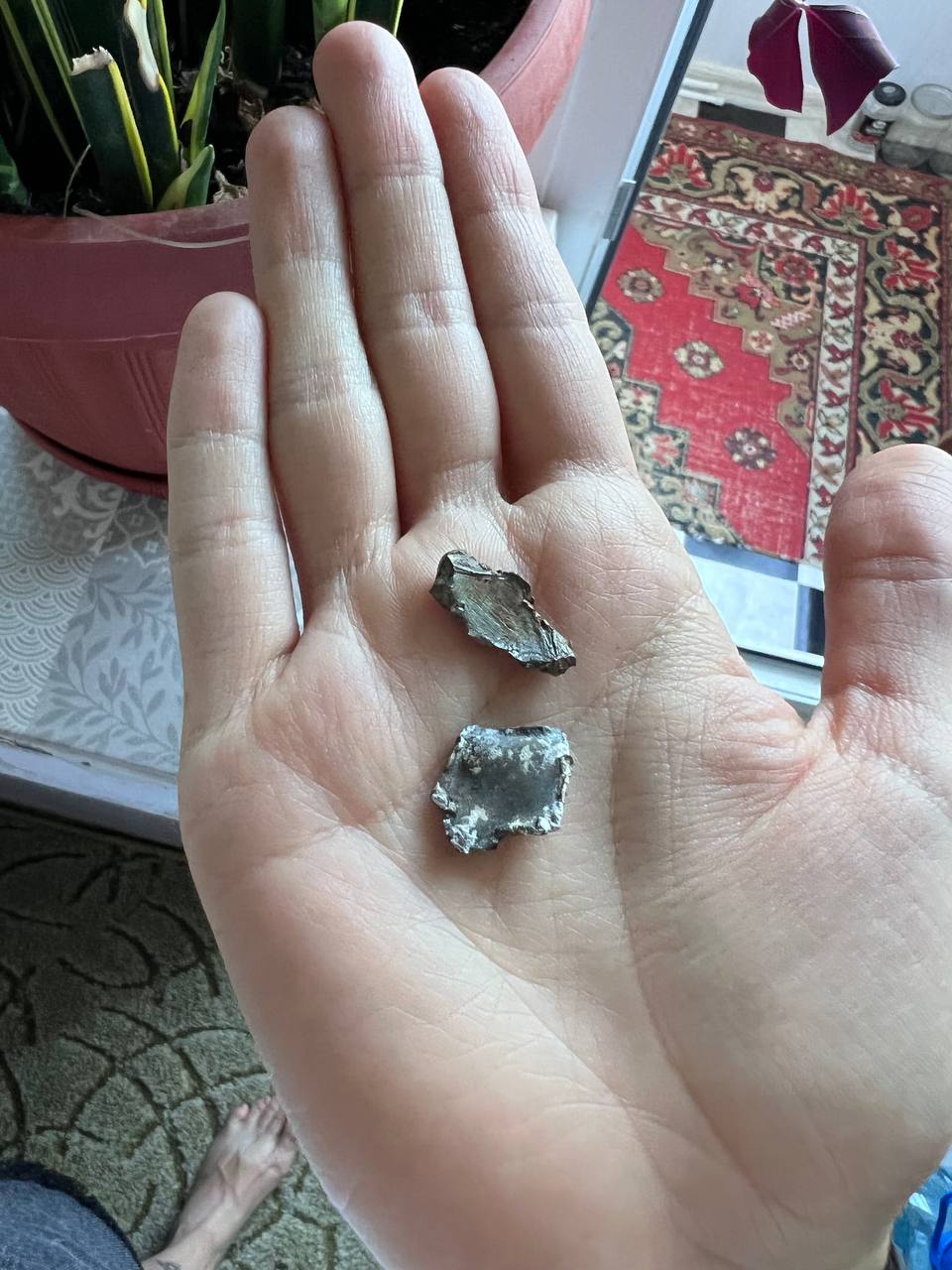
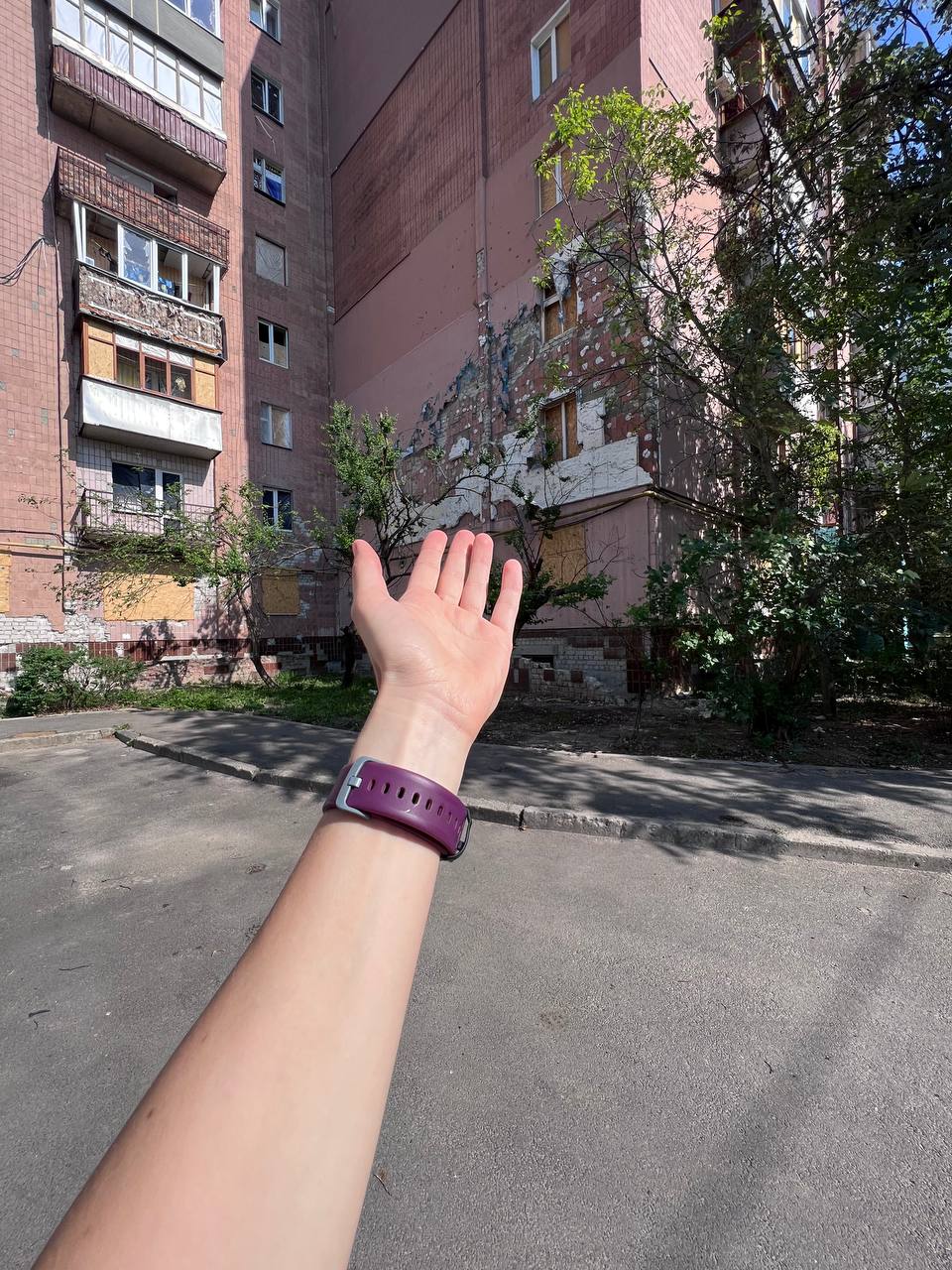
Kharkiv before and now: 3 main changes Alisa noticed in the city
- The total darkness and the curfew in the evening. “It’s like orienteering, you know this sport. You have to navigate by the sounds and smells”.
- The sounds. “The city is all about sounds now. And even when it’s quiet, you keep listening”.
- The diversity. It seems there is a place for anyone in this new Kharkiv, the civilians are having espresso next to the military, and people can work or fight or volunteer, don`t do any of that, or do all that at once.
The Kharkiv railway station now seemed the same as before the war. “I said to myself: okay, that’s the railway station. Looks normal. But then we drove along the avenue, and I saw the Czech hedgehogs and the damaged buildings”.

Alisa says her visit to Kharkiv felt like a hug, the city showed her all the best things. She went for a long walk, thinking: “It is my city and you can’t take that from me, so fuck you with all your attempts to stop us from living”. The woman enjoyed her espresso-tonic in her favorite coffee place and even sang karaoke in the volunteer Switch bar in the evening.
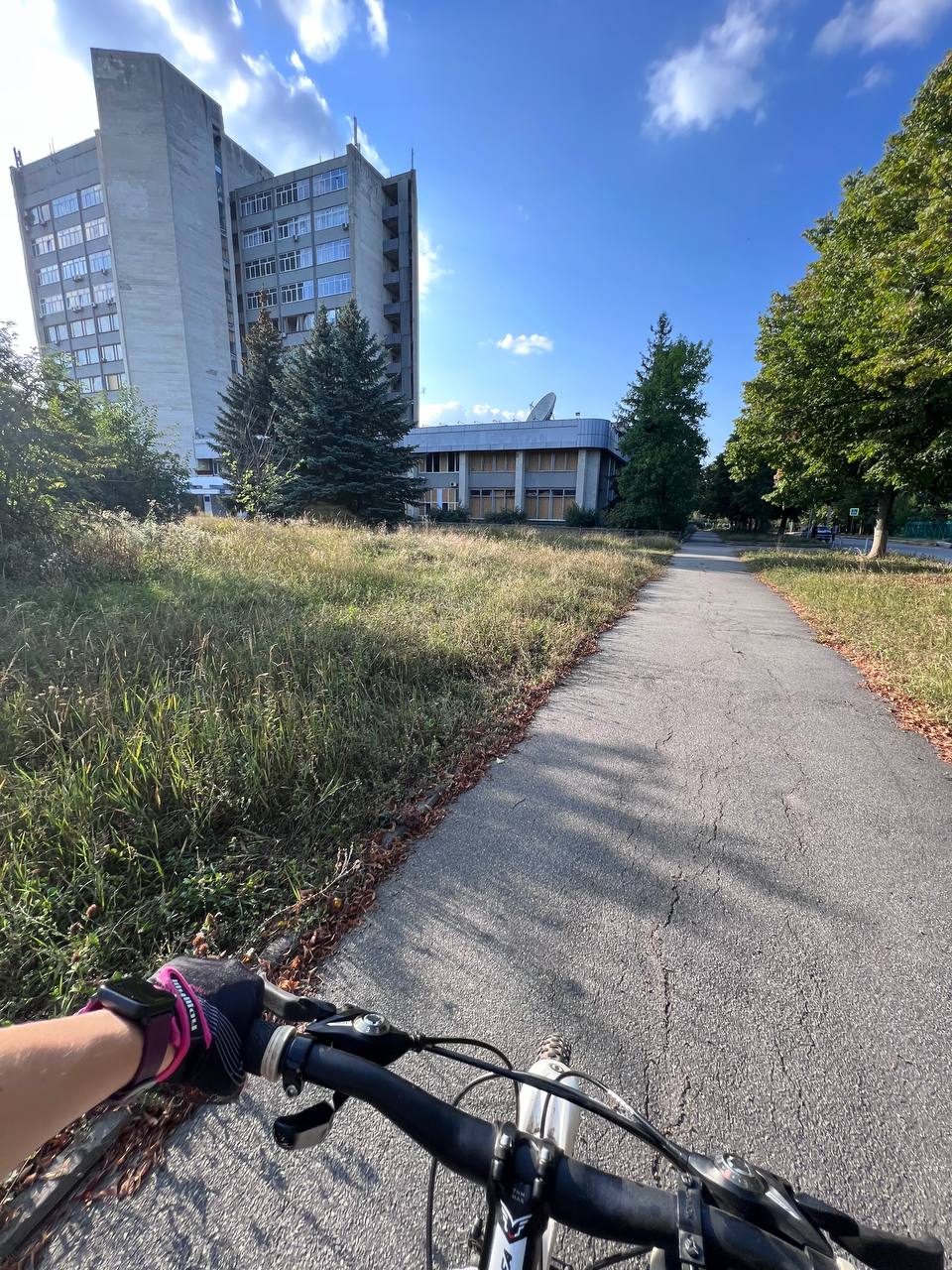
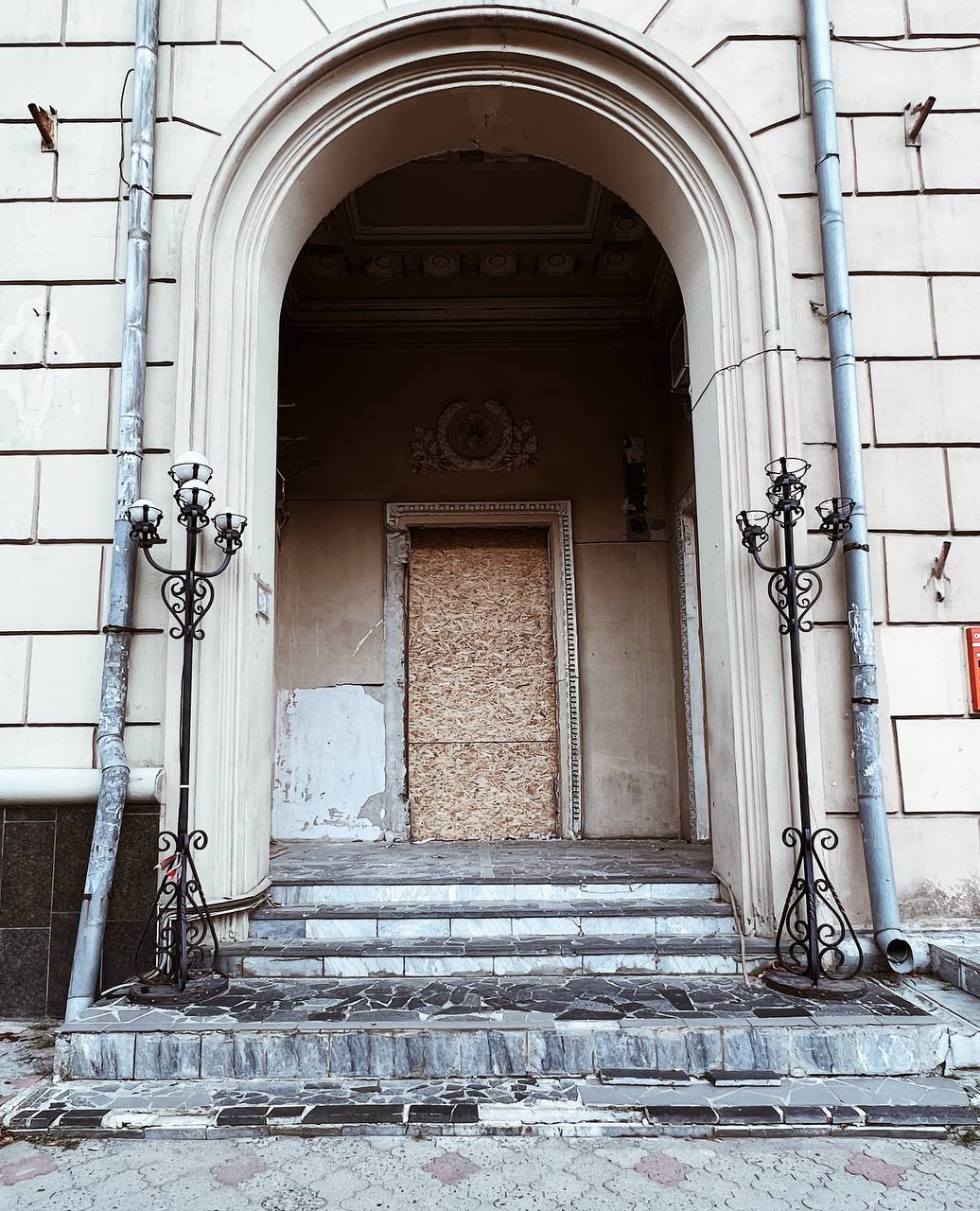
Alisa attended the performance “She the War” at Art Area DK, which helped her “to reflect on the performing experience we`ve had with the playback”. As an improvisational theater, they often staged the stories of loss and fear, shared by their audience.
Despite her love for the city, she confesses she’s not ready to settle in Kharkiv now. Alisa says the people who haven’t left the city got used to this tension, but it was hard for her to live with the night sirens that sometimes keep you awake till 5 a.m.
“I`m trying to trust my body, and it feels extremely tense and tight in constant danger. The anxiety and panic are not in my head, they are in my body. One day there were four air radar sirens one after another, I felt stressed and decided to take a hot bath. The windows were closed, but this stupid air radar app started to yell for the fifth time. I thought then: fuck off, I`m taking a bath! And then came the loud explosion, the house walls started vibrating. I remained calm, slowly got out of the bath tube, took my towel, and got dressed. I thought I wasn’t even stressed till I noticed my body was shaking.”
The first thing Alisa did in the city was a visit to Pyatykhatky, her native district to the south of Kharkiv only 28 km from the border with Russia. Pyatykhatky had been severely shelled daily for the first six months of the war. Despite that, Alisa`s father refused to abandon his home and decided to stay in Pyatykhatky.

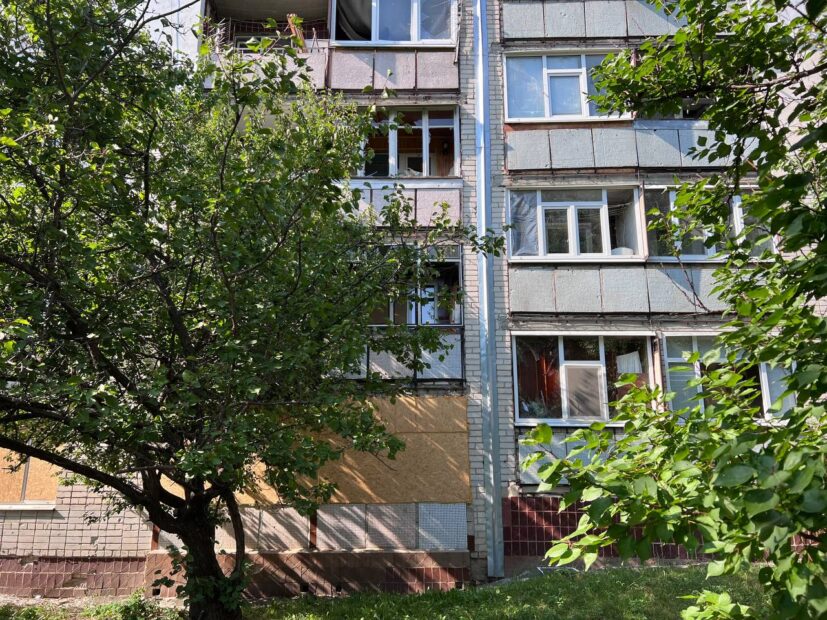
“Being there felt like a surreal full HD experience. You constantly hear the shelling and the explosions, and at the same time the birds are singing, and everything around is so green – it seems it has never been as green as this August! There are wild apples and pears and plums, and the vibe of an early morning when the streets are deserted, but nature has already woken up, is epic.”
Alisa cycled through her district to look at her school, now damaged by Russian attacks. She was impressed to see the Ukrainian flag on the ruined building.
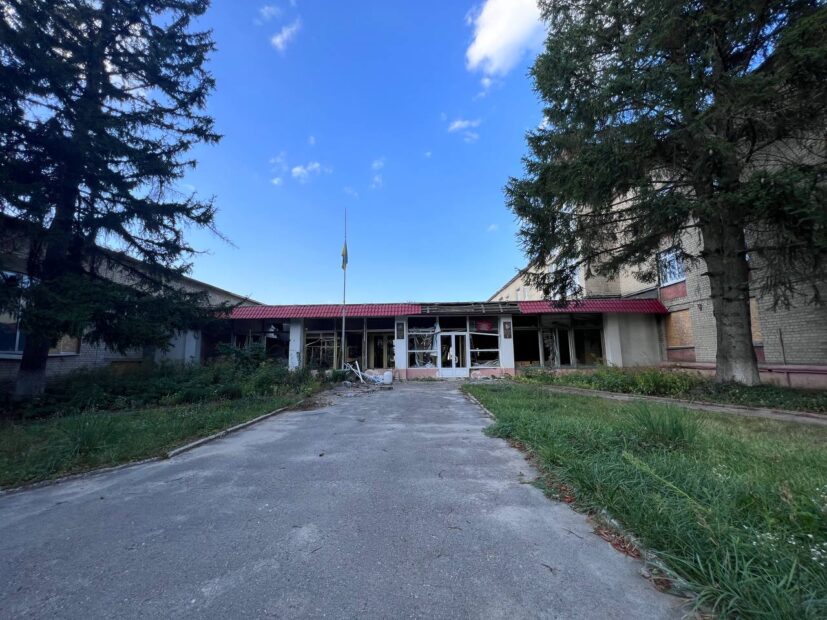
“They say now Kharkiv is a city-ferroconcrete. But to me, it’s more like a feral cat, who doesn`t mind more fights and more wounds, and uses any spare moment to stretch out under the sun and enjoy being alive.”
Alisa was stunned by a story told to her by a friend, volunteering in Kharkiv. The girl said the city collapsed on the first day of the war. All life was paralyzed, and people had to rebuild it from scratch. How to supply residents with food and medicine? How will the city function now? The volunteers had to restore the infrastructure from chaos.
“I used to think Kharkiv is a great city to live in, and I loved it. But now I know it’s the best city on Earth.”
Concluding her experience of visiting Kharkiv now Alisa highlights two words: respect and sympathy. “Everything I see in Kharkiv now feels like a fight and a wound at the same time”.
“It’s hard to describe the atmosphere in the city: all the incredible tension, and all the incredible patience to everything happening. The desperate desire to live and fight. The city is living its best, brightest moments now. Even now, it remains alive and comfortable, and people are not going to give up. Actually, they don’t even know what “give up” means.”
“Some Kharkiv buildings look like a crumpled Amazon cardboard box.” Sasha Kaverina about Kharkiv before and after war
Sasha Kaverina, 34, is a communication expert working in an IT company in Japan. She moved to Tokyo from Kharkiv five years ago but has regularly visited her hometown as her family and friends lived there. Sasha says the city has become more European, interesting, and developed in the five years she hasn’t been living there. “Every time I went home I was impressed by another new stylish cafe, city space or collaboration, a new IT startup or business”.
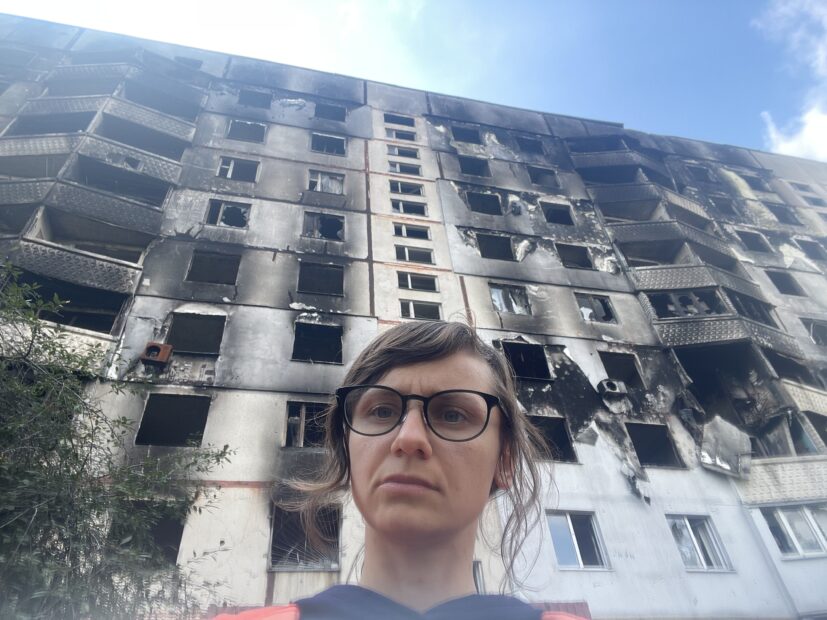
Even the war hasn’t stopped Sasha from coming to her homeland. In March she arrived in Ukraine to spend a few months with her family in Chernivtsi in the western part of Ukraine, as she wanted her parents to stay in a safer place than Kharkiv. But as soon as Sasha returned to Japan her parents moved back to their hometown.
The family`s house on the outskirts of Kharkiv was badly damaged by a Russian missile in early March. “The rocket struck our 16-story building, ruining the upper levels of the house. Luckily, my parents lived on the eighth floor, so they survived but were shocked. The windows in our apartment were broken, and the house is damaged.”
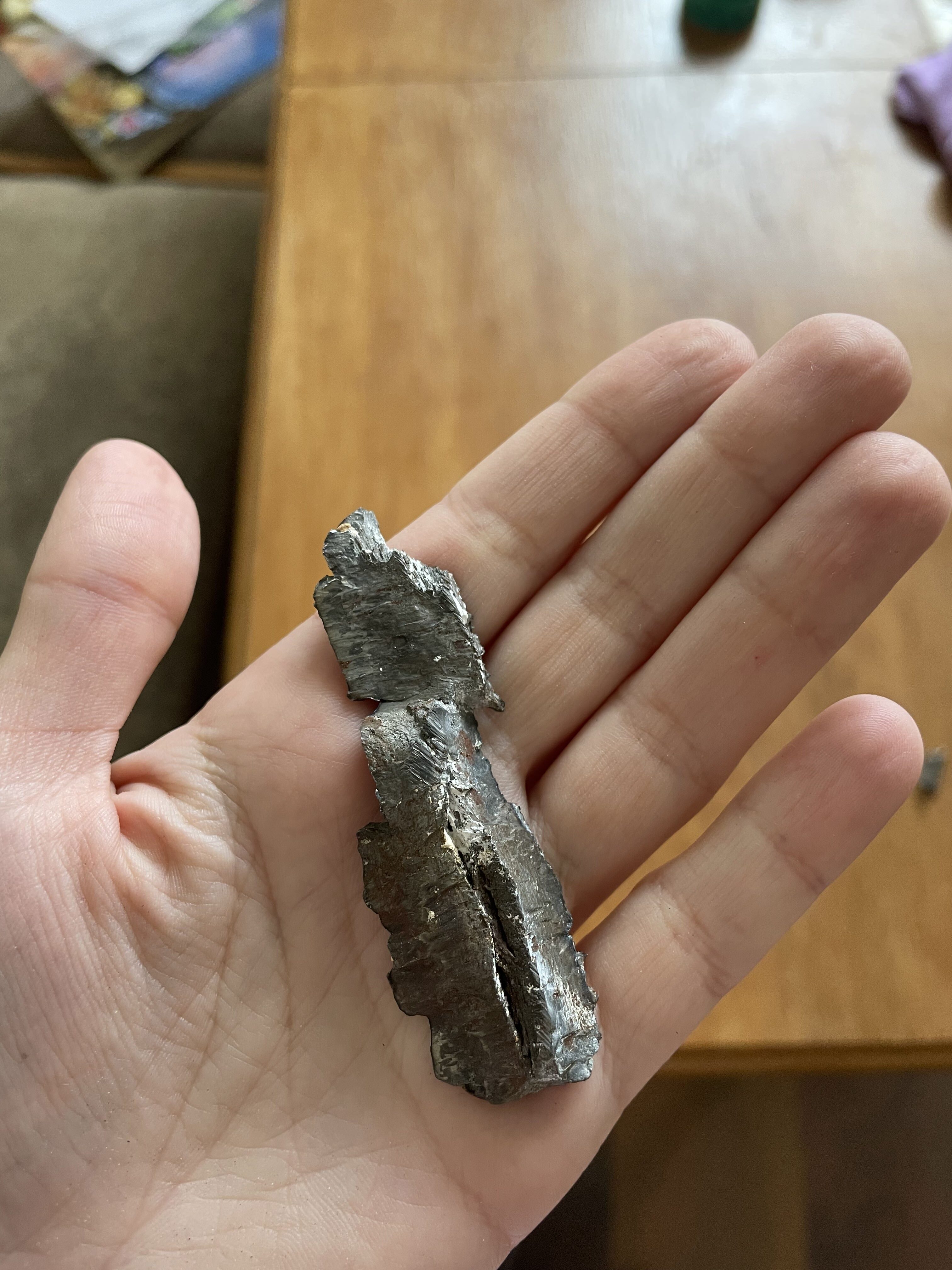
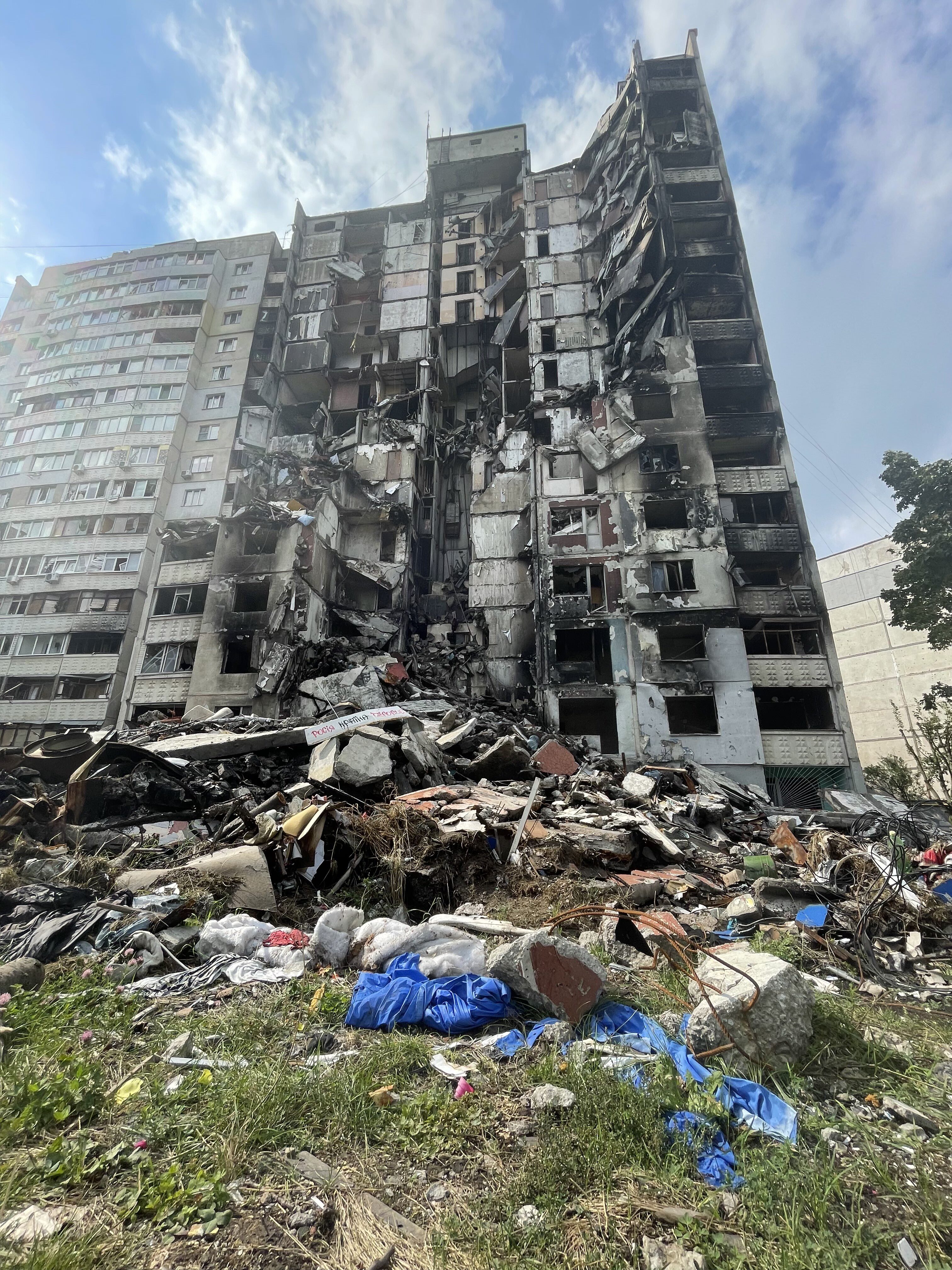
Now Sasha`s parents live in Kharkiv Oblast and commute daily to the city to work, as it’s crucial for them to feel useful and busy. “They love the city and don’t want to leave it. My parents believe that Kharkiv will be rebuilt, but are realistic about the approaching winter and have already stored some firewood”.
Sasha came to see her family and her hometown in September. She wanted to make sure her parents were ok, and to document the damage caused to the city by Russians to spread this evidence in Japan.
Kharkiv before and now: 3 main changes Sasha noticed in the city
- The atmosphere of the city-at-war: military cars everywhere, soldiers, journalists, and volunteers in the streets, and many retired people who couldn’t leave the city. Such a contrast with calm Kyiv or Lviv, which Sasha also visited during her trip to Ukraine.
- The toponyms, the names of Kharkiv squares and streets, keep being changed from Soviet to Ukrainian. “It’s the right thing to do and I feel no nostalgia for the Soviet names. I believe we need to rename the places after our new heroes of independent Ukraine instead of some past-times idols”.
- The ruined buildings have become a normal part of the cityscape – people can get their daily coffee fix in a place where the windows have been broken by the explosion.
“It was heartbreaking to come to my district on the outskirts of the city. The Russians attacked it severely during the first days of the war. I wanted to cry seeing the damaged supermarkets and the holes in the residential buildings, seeing the consequences of shelling at my house and the opposite building, where my friend used to live”.
Together with her father Sasha climbed the roof of her family’s house to look at the place where the Russian missile hit – it was possible to literally peer inside the building. “I could see the damaged electrical systems and other constructions, it looked like a Lego scattered by a careless child”.
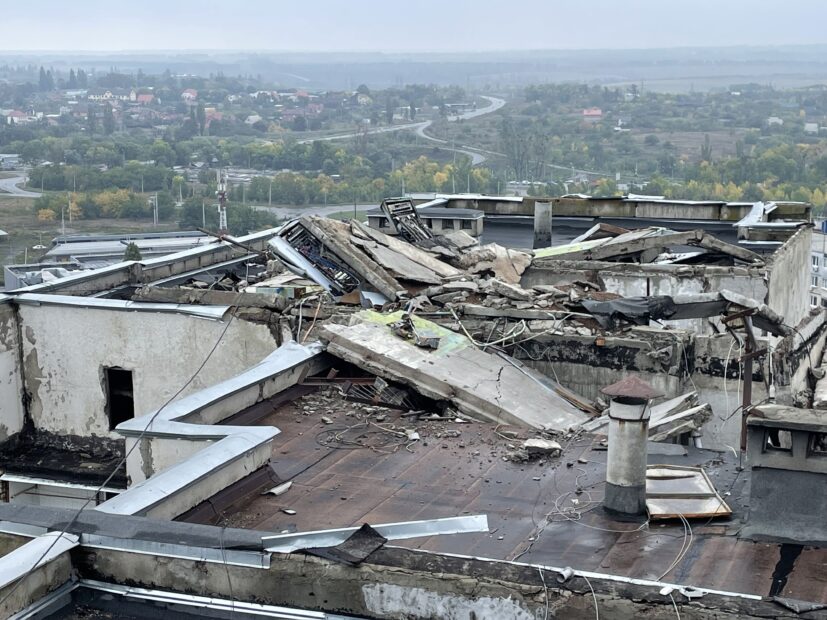
Being a founder of the volunteer movement supporting Ukraine in Japan, Sasha aimed to visit all the Kharkiv places most affected by war. She and her father explored the city by car, and the first ruined building they saw was the Kharkiv printing house.
“The only association I had looking at it was a cardboard box. I get lots of Amazon delivery, and this building looks the same as the empty boxes I crumple, getting ready to throw away for recycling. And it felt scary, as we are talking about a massive building. It seemed like some beast had bitten off the top of it. I was shocked.”
Shock, pain, and fear are the words Sasha describes her experience of touring the most damaged Kharkiv sights. She felt scared visiting Saltivka, the largest residential area in Kharkiv, badly suffering from the attacks during the first months of the full-scale invasion. “I saw the damaged houses and flats with all the toys and textbooks and home appliances left, and the old people waddling past that houses. It felt surreal, but the people still lived there”.
It was in the Saltivka district when Sasha heard the sounds of explosions. “I knew that Kharkiv Oblast had been liberated so felt relatively safe, though that sounds made me feel uncomfortable”.
“Once in the sky, I saw how our air defence forces shot down a Russian rocket. It didn’t feel scary, more… existential. At that moment I felt I was so small, a tiny human with all my tiny human plans for life, a month, even a day. But the truth is any moment I may simply stop existing”.

The main reason Sasha went to Saltivka was the Japanese volunteer Fuminori Tsuchiko, the 74 year old retiree who moved there in the first months of the war to support Kharkiv residents hiding in the shelter at Heroiv Pratsi metro station. Having spent his pension, the man moved to live in the shelter with the Ukrainians. Sasha`s Japanese volunteer community had been donating to the senior, so she wanted to meet him and see how he lives and what he does.
“I came downstairs to the metro station and saw a senior Japanese man. He made an excursion in the shelter for me, and then I talked to the local women. They told me how the elder man swept the floor in the metro and the nearby market every day, how he bought food and stuff for the children. He has even gifted them iPads for the first day of the school year.”
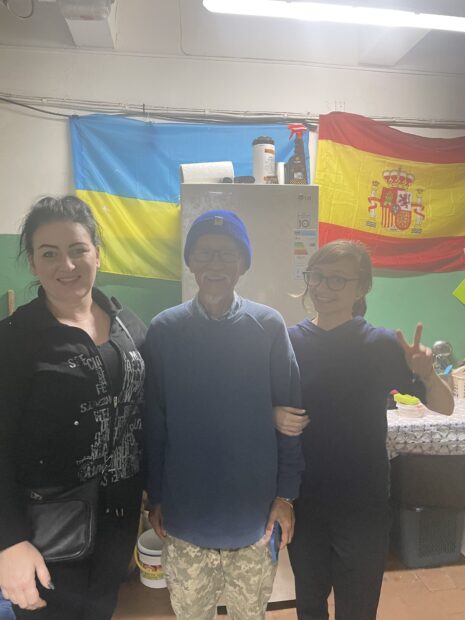
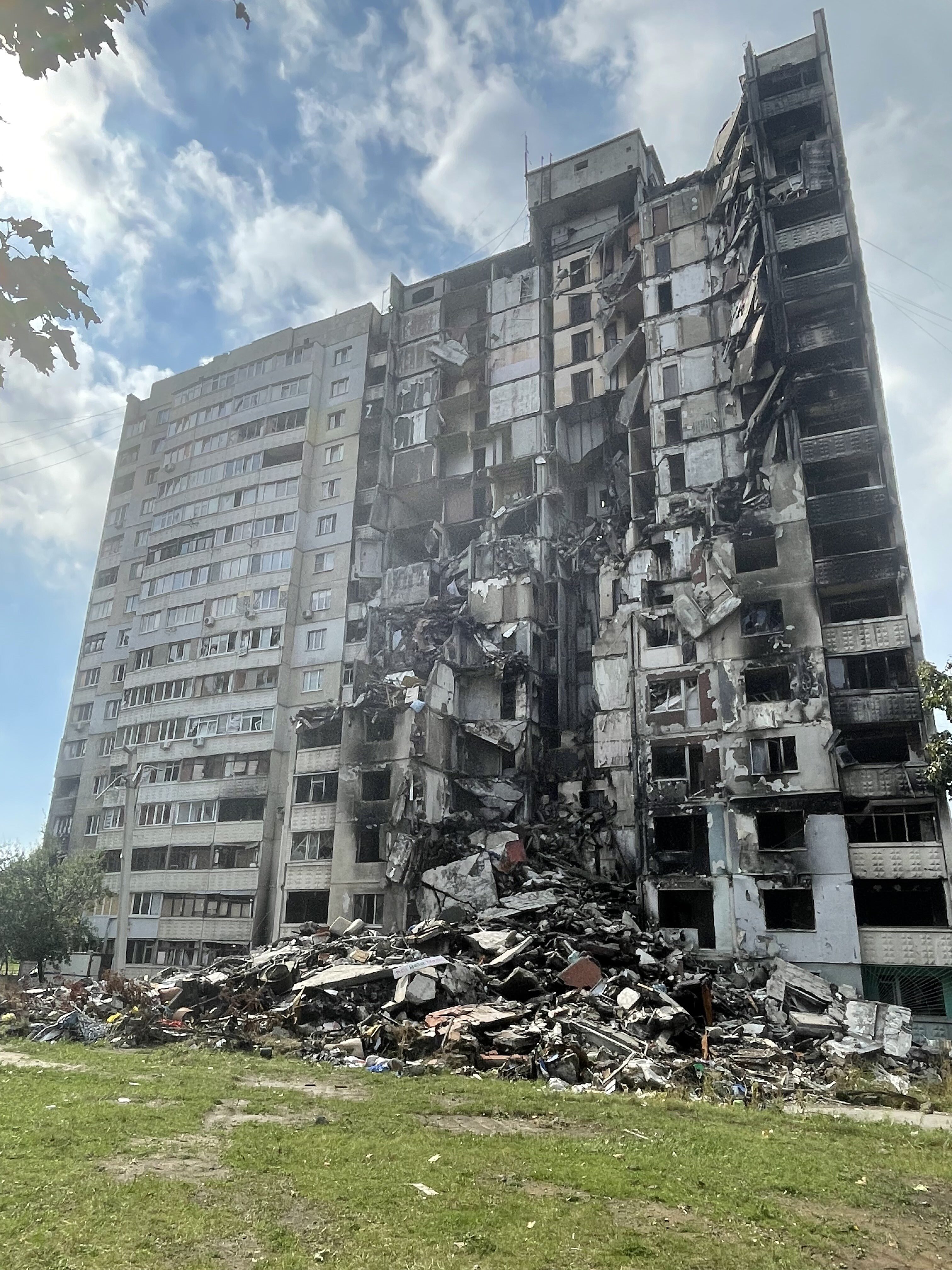
Kharkiv Freedom Square, sadly famous for the Kharkiv City Council building ruined by Russians in March, is another special place for Sasha, as the university she studied at is located there.
“Remember there`s always been a tent in front of the City Council, where people gathered to protest against something. The reasons have been changing, but the tent has remained – and is still standing in front of the damaged building. It was painful to see the streets I used to walk as a student so damaged.”
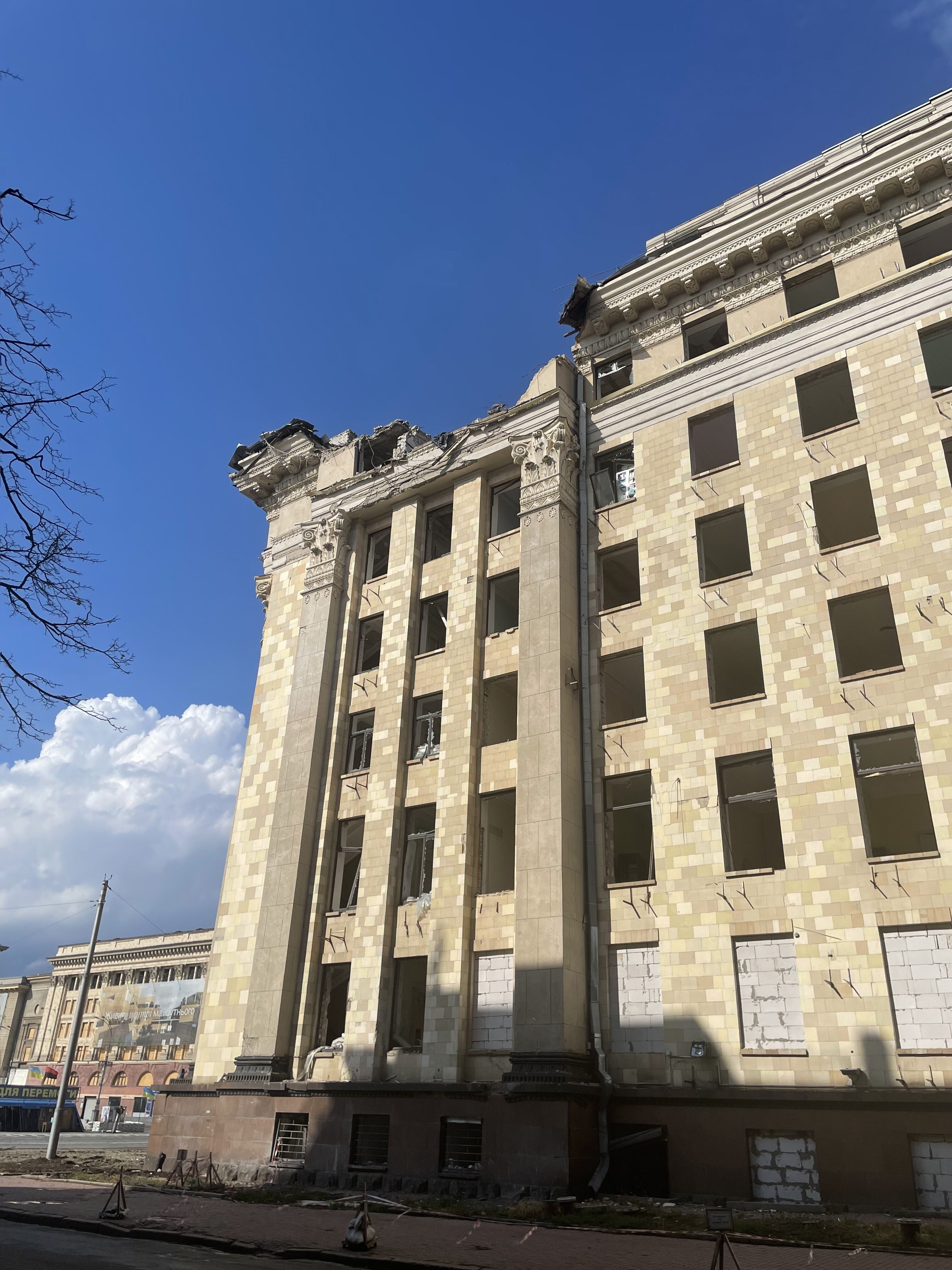


Sasha was pleased to notice a nostalgic cafe Crystal, a legendary Kharkiv place built in 1960, was still open. “We used to come there for pizza and ice cream with my university classmates”.
The woman wanted to visit the Skovoroda Kharkiv Pedagogical University, as they have a Japanese language department. She intended to hand over the book published in Japan. Sasha and the Japanese publishing house have gathered the stories of Ukrainians and released a collection of war diaries.
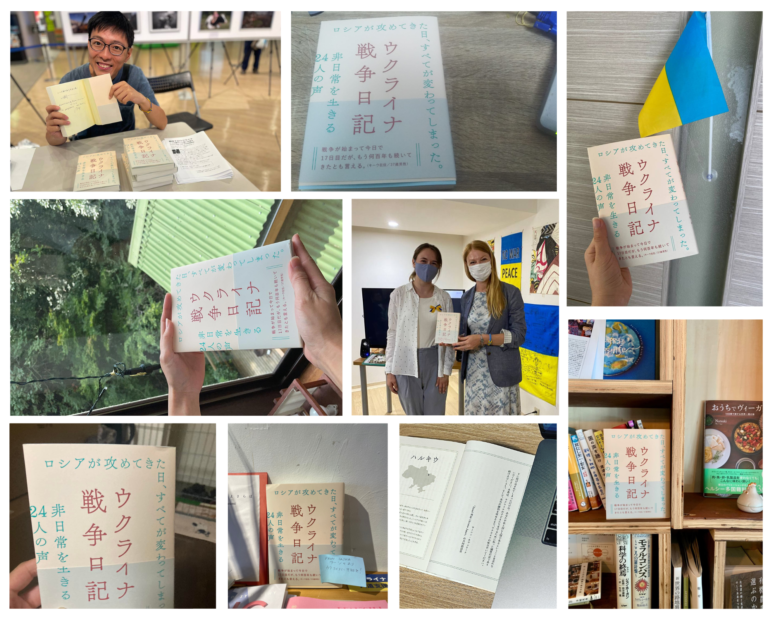
“Many Japanese think that the war in Ukraine is over. They are surprised to see my photos from Kharkiv. Japanese were impressed by the book. I think it’s hard for foreigners to see the real people behind the news feeds, and these dairies provide heart-to-heart contact”.
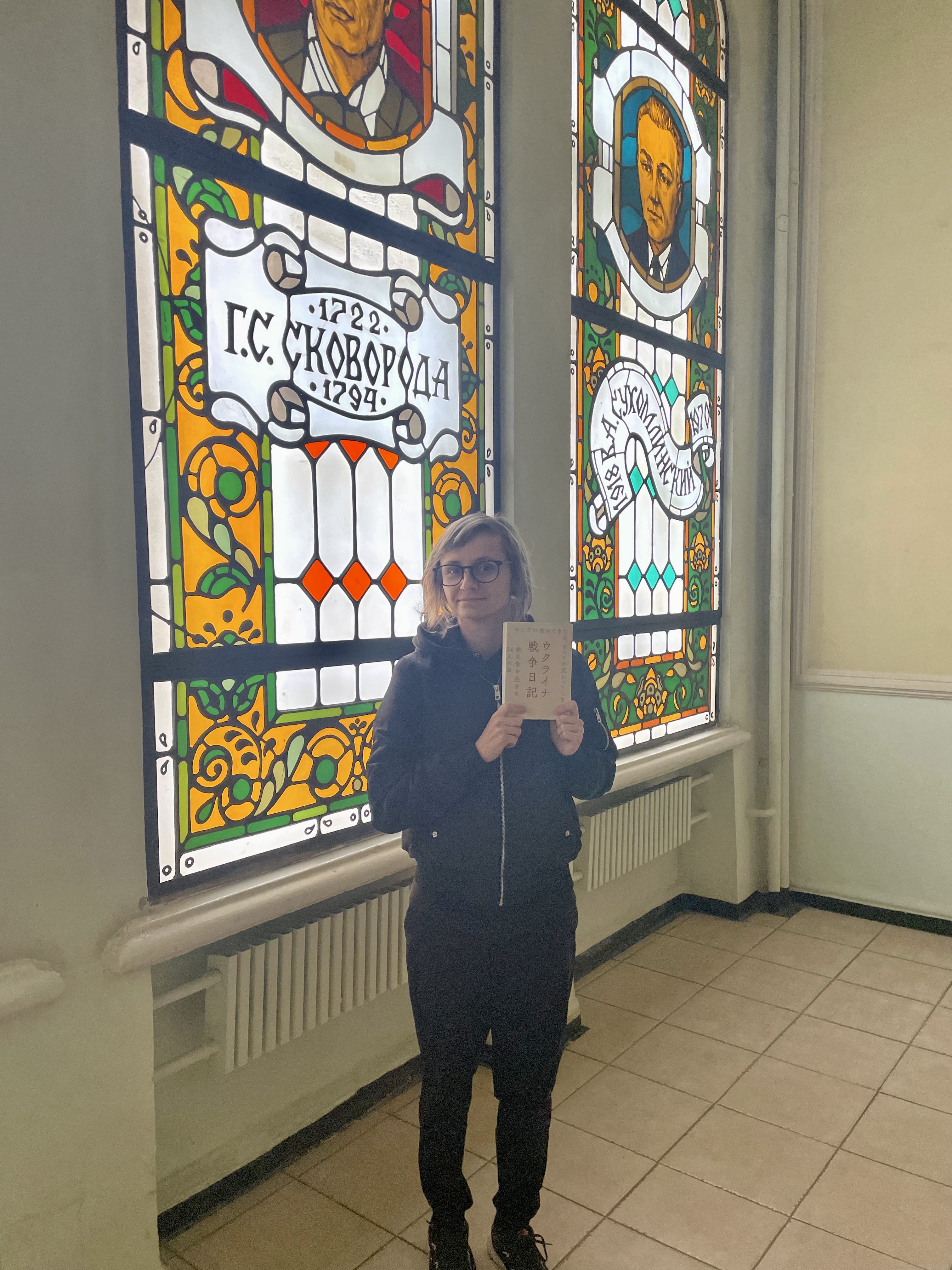
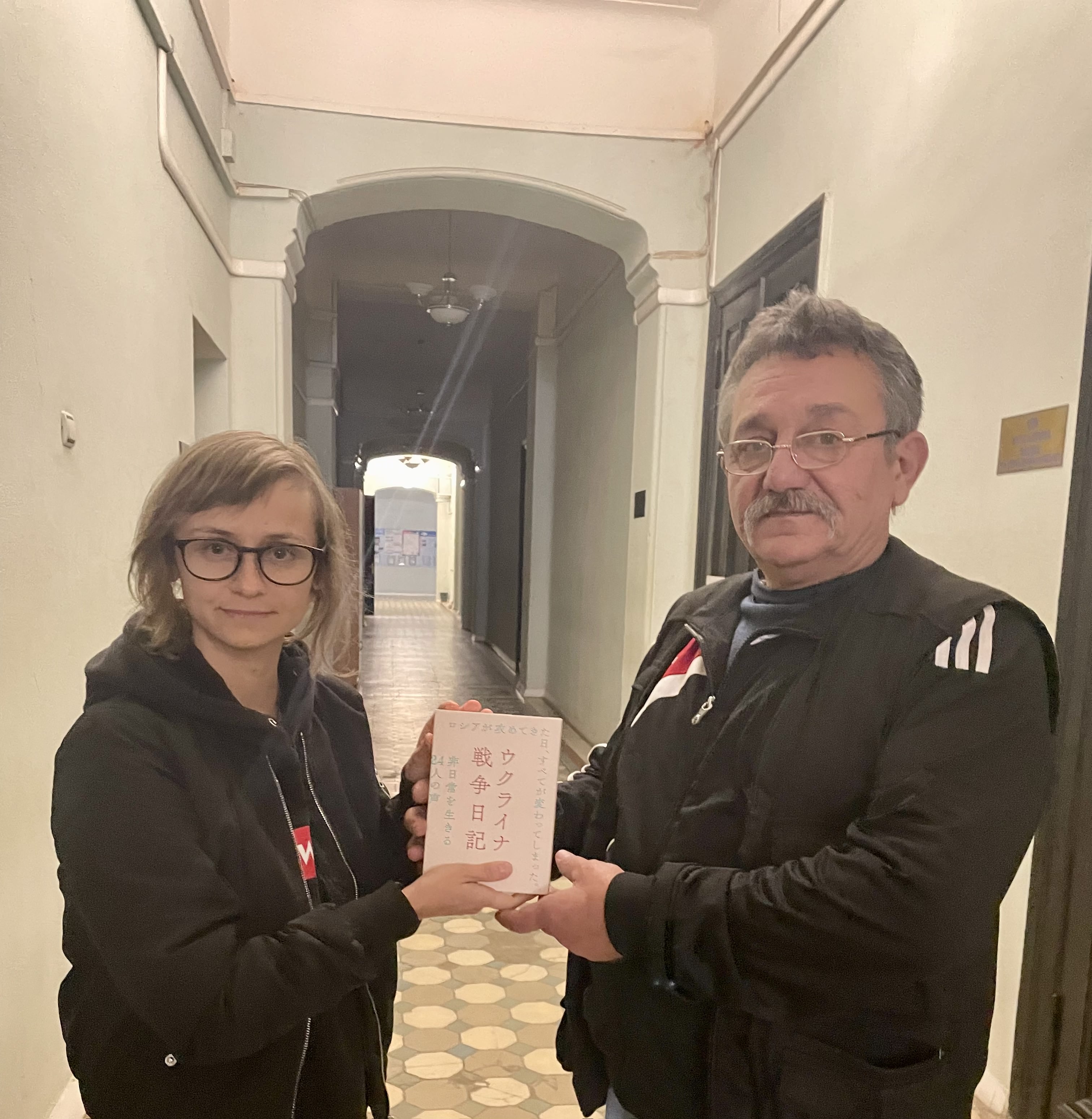
Sasha herself was impressed with how the Kharkiv citizens have got used to the situation. Her parents don’t even mind the air radar sirens. “You can easily distinguish a person who has returned to the city and someone who has been there from the very beginning. I think that’s what happens to the military – the more you stay in Kharkiv the more you “ossify”. This reminds Sasha of her favorite Hemingway’s books, where the characters had coffees, and parties and fell in love during the war. It used to astonish Sasha, but now she understands it, meeting her friend for a coffee in a central bar surrounded by damaged buildings. “War is the same in all times and all countries”.
Sasha left Kharkiv with a heavy heart, it felt wrong to go away from the city that required her help. “But I know if I stayed in Ukraine I wouldn’t work. In the current situation the only thing I can imagine doing in Kharkiv is volunteering”.
She keeps contributing even from Japan. One of the projects is Ukraine-style parties in Tokyo, where young locals, expats, and refugees can immerse themselves in Ukrainian culture, have fun and donate to Ukraine. One of these events was dedicated to Kharkiv.

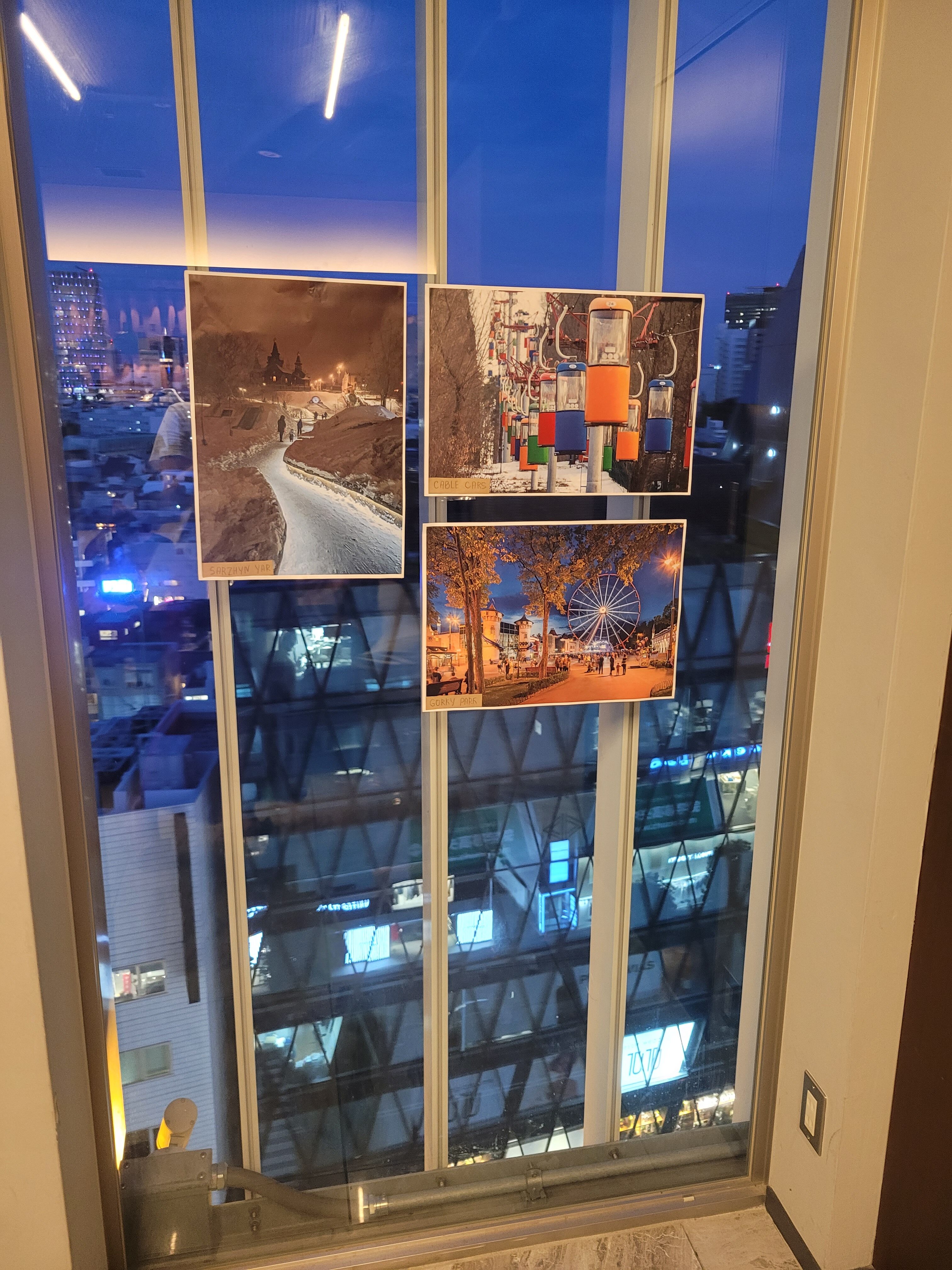

“Now they say Kharkiv is a city-ferroconcrete. We`re used to seeing Kharkiv as a strong city – sometimes marginal, sometimes rude, always unbreakable. It’s painful to see it injured, to see these black spots and scars. I’m sure it’s painful for all the Kharkiv residents. And we all have a huge scope of work ahead of us to rebuild our city – but we don’t even know when we`ll be able to start this work.”
